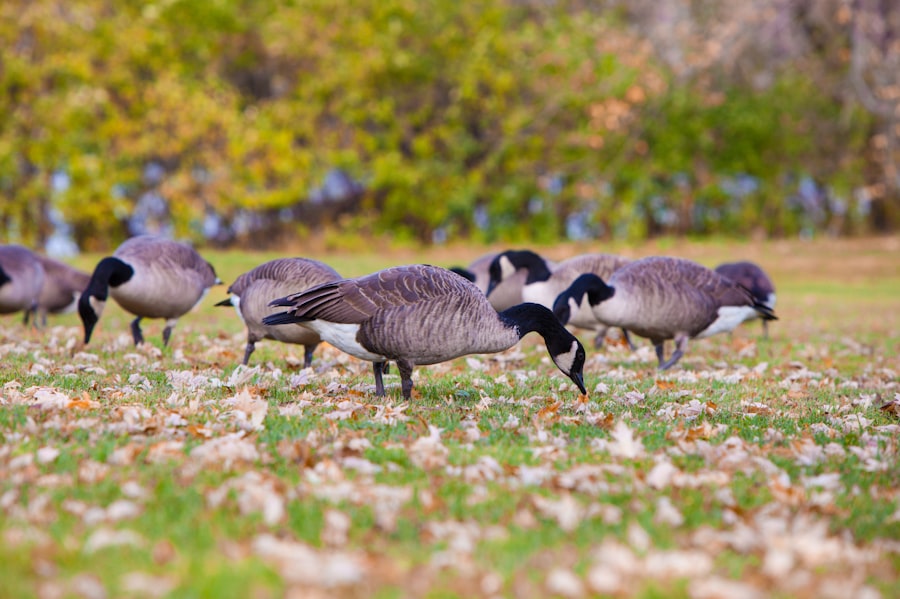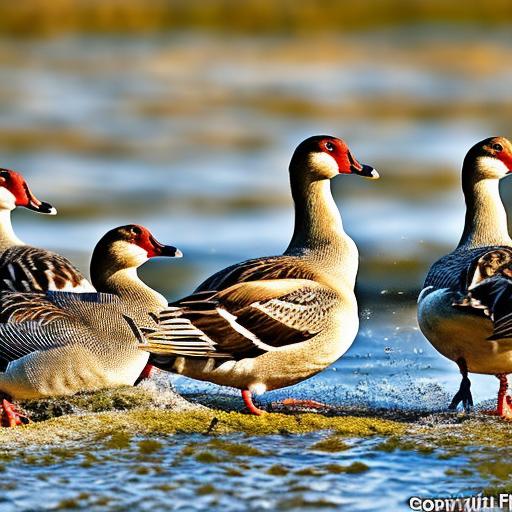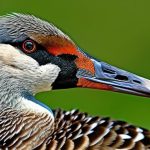Angry geese breeds are a unique and fascinating group of birds known for their aggressive behavior and territorial nature. They are called “angry” because they can become highly defensive and protective of their territory, often displaying aggressive behavior towards humans and other animals. Understanding the temperament of these birds is crucial for anyone who comes into contact with them, whether it be on a farm or in a natural setting.
It is important to note that not all geese breeds are angry. There are many different breeds of geese, each with its own temperament and characteristics. However, some breeds have a reputation for being more aggressive and territorial than others. These breeds are often referred to as “angry geese breeds” due to their tendency to display aggressive behavior.
Understanding the temperament of angry geese breeds is important for several reasons. Firstly, it helps ensure the safety of both humans and animals that may come into contact with these birds. Knowing how to interact with them in a way that minimizes the risk of aggression can help prevent accidents or injuries. Secondly, understanding their temperament allows us to appreciate and respect these birds for who they are, rather than viewing them as simply “angry” or aggressive creatures.
Key Takeaways
- Angry geese breeds have a reputation for being aggressive and territorial.
- The top 5 angry geese breeds are the Chinese, Embden, Toulouse, African, and Sebastopol.
- Angry geese breeds have been domesticated for thousands of years and were originally used for their meat, feathers, and eggs.
- Physical features that make angry geese breeds stand out include their large size, long necks, and distinctive coloring.
- Angry geese breeds can be beneficial for agriculture, as they are good at controlling pests and can serve as effective guard animals.
Top 5 Angry Geese Breeds and Their Characteristics
1. Chinese Goose: The Chinese goose is one of the most well-known angry geese breeds. They are medium-sized birds with a distinctive knob on their forehead. Chinese geese are known for their loud honking and aggressive behavior when defending their territory. Despite their aggressive nature, they are also known to be good parents and can be quite affectionate towards their human caretakers.
2. African Goose: The African goose is another breed known for its aggressive behavior. They are large birds with a muscular build and a strong beak. African geese are highly territorial and will not hesitate to chase away intruders. They are also known for their loud honking, which can be quite intimidating. Despite their aggressive nature, African geese are also known to be intelligent and can be trained to perform simple tasks.
3. Embden Goose: The Embden goose is a breed that originated in Germany. They are large birds with a pure white plumage and a distinctive orange beak and feet. Embden geese are known for their aggressive behavior, especially during the breeding season when they become highly territorial. They are also known for their loud honking, which can be heard from a distance. Despite their aggressive nature, Embden geese are also known to be good foragers and can adapt well to different environments.
4. Toulouse Goose: The Toulouse goose is a breed that originated in France. They are large birds with a grayish plumage and a distinctive knob on their forehead. Toulouse geese are known for their aggressive behavior and can be quite territorial, especially during the breeding season. They are also known for their loud honking, which can be heard from a distance. Despite their aggressive nature, Toulouse geese are also known to be good parents and can form strong bonds with their human caretakers.
5. Pilgrim Goose: The Pilgrim goose is a breed that originated in the United States. They are medium-sized birds with a grayish plumage and a distinctive white stripe on their head. Pilgrim geese are known for their calm and docile temperament, making them less aggressive compared to other angry geese breeds. However, they can still display territorial behavior if they feel threatened or if their territory is invaded.
The History of Angry Geese Breeds: How They Evolved Over Time
Geese have been domesticated for thousands of years and have played an important role in human history. The domestication of geese is believed to have started in ancient Egypt, where they were raised for their meat, eggs, and feathers. Over time, different breeds of geese were developed for specific purposes, including as guard animals and for their aggressive behavior.
The evolution of angry geese breeds can be traced back to the selective breeding practices of early farmers. Farmers would choose geese with more aggressive and territorial behavior to breed, resulting in offspring with similar traits. This selective breeding process continued over generations, leading to the development of specific breeds known for their angry temperament.
In the past, angry geese breeds were primarily used as guard animals on farms. Their aggressive behavior and loud honking served as a deterrent to potential intruders, making them an effective form of security. They were also used to protect other livestock from predators, as their territorial nature made them highly vigilant and protective.
The Physical Features of Angry Geese Breeds: What Makes Them Stand Out
Angry geese breeds have several physical features that set them apart from other geese breeds. These features not only contribute to their aggressive behavior but also make them visually distinct.
One common physical feature among angry geese breeds is the presence of a knob on their forehead. This knob is a fleshy growth that develops on the top of their head and is more prominent in males than females. The knob serves no functional purpose but is believed to be a result of selective breeding for aggressive behavior.
Another physical feature that distinguishes angry geese breeds is their size and build. Many angry geese breeds are larger and more muscular than other geese breeds. This physical strength allows them to defend their territory more effectively and makes them more intimidating to potential threats.
The plumage of angry geese breeds can also vary, with some breeds having distinct color patterns or markings. For example, the Embden goose has a pure white plumage, while the Toulouse goose has a grayish plumage. These distinct color patterns can make them more visually striking and help them stand out among other geese breeds.
Angry Geese Breeds and Their Role in Farming: Are They Good for Agriculture?
Angry geese breeds have long been used in agriculture for various purposes. Their aggressive behavior and territorial nature make them effective guard animals, as they can deter potential intruders and protect other livestock from predators. Additionally, their loud honking can serve as an alarm system, alerting farmers to any potential threats.
Using angry geese breeds in agriculture has several benefits. Firstly, they provide a cost-effective form of security. Unlike other security measures such as alarms or surveillance systems, geese do not require any additional expenses once they are acquired. They are also low-maintenance animals that can thrive in different environments, making them suitable for a wide range of farming operations.
Furthermore, angry geese breeds can help control pests on the farm. Geese are natural grazers and will eat a variety of plants, including weeds and insects. This can help reduce the need for chemical pesticides and herbicides, making them an environmentally friendly option for pest control.
However, there are also challenges associated with using angry geese breeds in farming. One challenge is their aggressive behavior towards humans and other animals. While this aggression can be beneficial for protecting the farm, it can also pose a risk to farm workers or other animals on the property. Proper training and handling techniques are necessary to ensure the safety of both humans and animals.
The Behavior of Angry Geese Breeds: How They Interact with Humans and Other Animals

The behavior of angry geese breeds is characterized by their territorial nature and aggressive tendencies. They are highly protective of their territory and will display aggressive behavior towards anyone or anything that they perceive as a threat.
When interacting with humans, angry geese breeds may hiss, flap their wings, or charge at the perceived threat. They may also bite or peck if they feel threatened or cornered. It is important to approach them with caution and respect their personal space to avoid triggering their aggressive behavior.
In terms of their behavior towards other animals, angry geese breeds can be territorial and may display aggression towards intruders. This can be beneficial in a farming setting, as they can help protect other livestock from predators. However, it is important to introduce them to other animals gradually and monitor their interactions to ensure the safety of all animals involved.
Angry geese breeds also have their own unique way of communicating with each other. They use a combination of vocalizations, body language, and physical displays to communicate their intentions and establish dominance within their flock. Understanding these communication cues can help humans better understand and interact with these birds.
Angry Geese Breeds and Their Intelligence: Can They Be Trained?
Angry geese breeds are known for their intelligence and can be trained to some extent. While they may not be as trainable as dogs or other domesticated animals, they can learn simple commands and behaviors with consistent training and positive reinforcement.
One example of training for angry geese breeds is teaching them to respond to a specific command or signal. For example, they can be trained to come when called or to move to a specific location on command. This can be useful in a farming setting, where farmers may need to move the geese from one area to another.
Training can also help modify certain behaviors in angry geese breeds. For example, if a goose is displaying aggressive behavior towards humans, training can be used to redirect that aggression towards more appropriate targets, such as intruders or predators.
It is important to note that training angry geese breeds requires patience, consistency, and positive reinforcement. Punishment-based training methods are not recommended, as they can increase aggression and fear in these birds. Instead, rewards such as treats or praise should be used to reinforce desired behaviors.
The Challenges of Raising Angry Geese Breeds: Tips for Handling Them Safely
Raising angry geese breeds can be challenging due to their aggressive behavior and territorial nature. However, with proper handling and care, these challenges can be managed effectively.
One of the main challenges of raising angry geese breeds is their aggression towards humans. It is important to establish boundaries and respect their personal space to avoid triggering their aggressive behavior. Approaching them calmly and confidently, without making sudden movements or loud noises, can help minimize the risk of aggression.
Another challenge is their aggression towards other animals. If introducing them to other animals, it is important to do so gradually and under controlled conditions. Monitoring their interactions and providing separate spaces for each animal can help prevent conflicts and ensure the safety of all animals involved.
Proper handling techniques are also crucial for the safety of both humans and geese. It is important to handle them with care and avoid grabbing or restraining them forcefully, as this can increase their stress levels and trigger aggressive behavior. Instead, using gentle handling techniques and positive reinforcement can help build trust and create a positive relationship between humans and geese.
Angry Geese Breeds and Their Conservation Status: Are They Endangered?
The conservation status of angry geese breeds varies depending on the specific breed and its population size. While some breeds may be more common and have stable populations, others may be less common and face threats to their survival.
It is important to note that angry geese breeds are not recognized as a distinct group by conservation organizations. Instead, they are considered part of the broader category of domesticated geese. As such, their conservation status is often tied to the conservation efforts for domesticated geese as a whole.
Threats to the population of domesticated geese, including angry geese breeds, can include habitat loss, predation, and disease. Additionally, the demand for geese products such as meat and feathers can also impact their population size.
Conservation efforts for domesticated geese focus on maintaining genetic diversity and promoting sustainable breeding practices. This includes preserving rare or endangered breeds, promoting responsible breeding, and raising awareness about the importance of domesticated geese in agriculture and cultural heritage.
The Fascinating World of Angry Geese Breeds and Their Importance in Nature
In conclusion, angry geese breeds are a unique group of birds known for their aggressive behavior and territorial nature. Understanding their temperament, physical features, behavior, and role in farming is crucial for anyone who comes into contact with them.
While they may be challenging to raise and handle, angry geese breeds play an important role in agriculture as guard animals and pest controllers. Their aggressive behavior and territorial nature make them effective at protecting farms and other livestock from potential threats.
Appreciating and understanding angry geese breeds is important for their conservation and well-being. By respecting their personal space, providing proper care and handling, and promoting responsible breeding practices, we can ensure the survival of these fascinating birds for future generations to appreciate.
If you’re interested in learning more about angry geese breeds and their breeding process, you might also find this article on the incubation period for goose eggs helpful. Understanding the incubation period is crucial for successful breeding and hatching. To learn more about it, check out https://poultrywizard.com/breeding-geese/what-is-the-incubation-period-for-goose-eggs/. Additionally, if you’re considering raising chickens alongside your geese, you may want to explore this article on the Snaplock Chicken Coop, which offers a secure and convenient housing solution for your poultry. Find out more at https://poultrywizard.com/keeping-chickens/snaplock-chicken-coop/.
FAQs
What are angry geese breeds?
Angry geese breeds are types of geese that are known for their aggressive behavior towards humans and other animals.
What are some examples of angry geese breeds?
Some examples of angry geese breeds include the Chinese Goose, the Embden Goose, and the Toulouse Goose.
Why are these geese breeds so aggressive?
These geese breeds are naturally territorial and protective of their nests and young. They may also become aggressive if they feel threatened or cornered.
Can angry geese breeds be kept as pets?
While some people do keep angry geese breeds as pets, it is important to understand their aggressive tendencies and take proper precautions to ensure the safety of both the geese and humans.
What precautions should be taken when dealing with angry geese breeds?
When dealing with angry geese breeds, it is important to give them plenty of space and avoid approaching them too closely. If they do become aggressive, it is best to back away slowly and avoid making sudden movements. Protective clothing, such as gloves and boots, may also be necessary.
Meet Walter, the feathered-friend fanatic of Florida! Nestled in the sunshine state, Walter struts through life with his feathered companions, clucking his way to happiness. With a coop that’s fancier than a five-star hotel, he’s the Don Juan of the chicken world. When he’s not teaching his hens to do the cha-cha, you’ll find him in a heated debate with his prized rooster, Sir Clucks-a-Lot. Walter’s poultry passion is no yolk; he’s the sunny-side-up guy you never knew you needed in your flock of friends!







